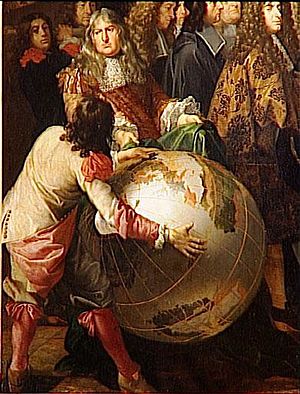Gilles de Roberval facts for kids
Quick facts for kids
Gilles de Roberval
|
|
|---|---|

Portrait of Gilles Personne de Roberval (1602-1675) at the inauguration of the French Academy of Sciences, 1666, where he was a founding member.
|
|
| Born | August 10, 1602 Roberval near Beauvais, France
|
| Died | October 27, 1675 (aged 73) Paris, France
|
| Nationality | French |
| Known for | Roberval Balance Coining the term 'trochoid' |
| Scientific career | |
| Fields | Mathematician |
| Institutions | Gervais College, Paris Royal College of France |
| Academic advisors | Étienne Pascal Marin Mersenne |
| Notable students | François du Verdus Isaac Barrow |
| Influences | Pierre de Fermat |
| Influenced | Blaise Pascal |
Gilles Personne de Roberval (born August 10, 1602 – died October 27, 1675) was a French mathematician. He was born in a place called Roberval, near Beauvais, France. His original name was Gilles Personne, and he took "de Roberval" from his birthplace.
Contents
Life and Career of Gilles de Roberval
Like the famous thinker René Descartes, Roberval was present at the siege of La Rochelle in 1627. In the same year, he moved to Paris. In 1631, he became a professor of philosophy at Gervais College in Paris.
Just two years later, in 1633, he also became the professor of mathematics at the Royal College of France. A special rule for this job was that the professor had to suggest math problems. If someone else solved them better, the professor had to step down. Even with this rule, Roberval kept his position until he died.
Roberval's Mathematical Discoveries
Roberval was one of the mathematicians who worked on problems that are now solved using infinitesimal calculus. This is a type of math that deals with very small changes. He focused on finding the area of surfaces (called quadrature) and the volume of solids (called cubature).
Method of Indivisibles
Roberval found a way to do this for simpler shapes. He called his method the "Method of Indivisibles." This method involved breaking down shapes into many tiny, simple pieces. However, he kept his method secret for a while. Because of this, he lost some credit for the discovery. Another mathematician, Bonaventura Cavalieri, published a similar method that he had invented on his own.
Drawing Tangents and Robervallian Lines
Roberval also found a very general way to draw tangents. A tangent is a straight line that touches a curve at only one point. He thought of a curve as being drawn by a moving point. The movement of this point was made up of several simpler movements.
He also found a way to create new curves from existing ones. Using this method, he could find areas that were equal to the space between certain curves and their asymptotes. An asymptote is a line that a curve gets closer and closer to but never actually touches. Another mathematician, Evangelista Torricelli, named these special curves "Robervallian lines."
Disagreements with Descartes
Roberval and René Descartes did not get along well. Roberval felt jealous because Descartes criticized some of his methods. This led Roberval to criticize and oppose the new analytical methods that Descartes brought into geometry around that time.
Other Contributions
Besides pure mathematics, Roberval also worked on other things. He wrote about the system of the universe, supporting the idea that the Earth goes around the Sun. This is known as the Copernican heliocentric system. He also believed that all tiny bits of matter attract each other.
Roberval also invented a special kind of balance. This invention is known as the Roberval Balance.
Works
- Traité de Mécanique des Poids Soutenus par des Puissances sur des Plans Inclinés à l’Horizontale (1636)
- Le Système du Monde d’après Aristarque de Samos (1644)
- Divers Ouvrages de M. de Roberval (1693)
See also
 In Spanish: Gilles de Roberval para niños
In Spanish: Gilles de Roberval para niños

